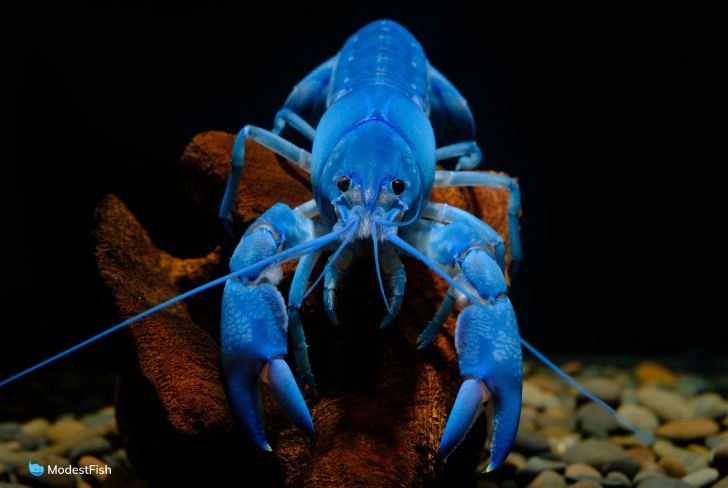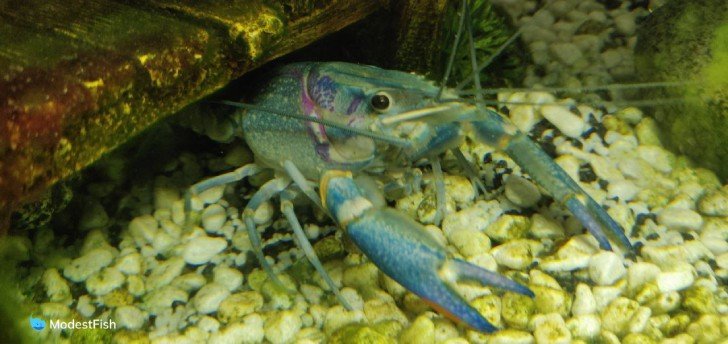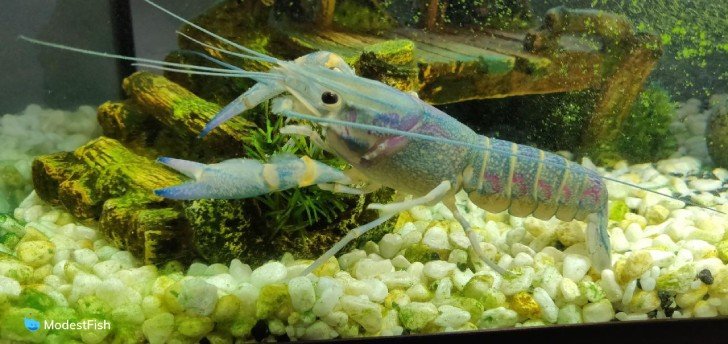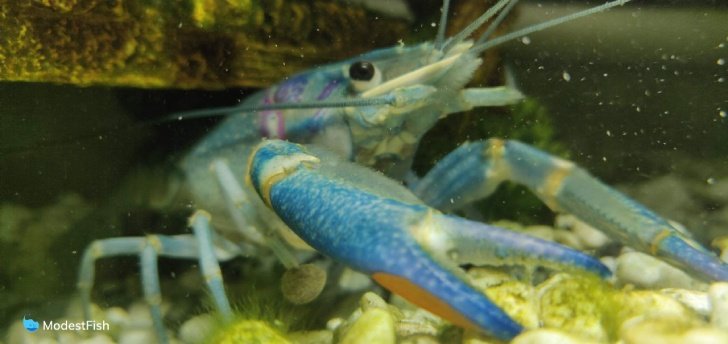Blue crayfish aren’t ideal for everyone. They must be kept in their own tank, and they love nothing more than ripping up every plant you added into their environment.
However, saying that, blue crayfish have tons of personality and when in the right conditions, can be wonderful to watch.
In this guide, I’ll walk you through everything you need to know in order to create the best environment and set up the ideal tank for a blue crayfish.
Blue Crayfish Quick Stats
- Care Level: medium
- Min. Tank Size: 30 gallons (113 liters)
- pH: 7.0-8.0
- Temperature: 65°-82°F (18°-28°C)
- Diet: omnivore
- Temperament: aggressive
- Lifespan: 5 years
- Size: 5 inches (13 centimeters)
- Family: Cambaridae
- How many can be kept together: should be kept alone in a dedicated tank
- Scientific Name: Procambarus alleni
- Common Name: Everglades crayfish, Florida crayfish, sapphire crayfish, electric blue crayfish
Is it Crayfish or Crawfish or Crawdad?
All of the above! I know, pretty weird, but all three forms of the word are correct. The pronunciation and spelling mostly depends on geography.
It’s “crayfish” in Australia and the United Kingdom, as well as the northeastern United States. It’s “crawfish” in the American South and “crawdad” in the West and Southwest.
I’ve also often heard the terms crawdaddy and mud bug in the South. So, call them whatever you want, I won’t judge you.
In my personal life, I say crawfish. But, for the purposes of this article, I’ll call them crayfish since that is the internationally accepted term.
Appearance

OK this is a seriously cool looking little creature. To put it simply, blue crayfish look like a miniature lobster.
They have a segmented exoskeleton, the first section being the head, which has a sharply pointed rostrum that sprouts several sets of antennae that whip around as they explore the substrate.
They have black eyes that move around on short stocks, watching out for food and predators.
The next segment is the carapace, the biggest section of the body.
Their front pair of legs, called chelipeds, jut forward like two beefy arms and are tipped with sharp pincers, or chelae. These claws are sharply pointed and can deliver a very nasty pinch, even to a human.
Crayfish use these claws to grab food, fight off other crayfish and to defend themselves against predators.
Four more sets of walking legs are behind the chelipeds.
Crayfish don’t swim in the open water very often, especially as adults. They walk to move forward and only ever swim to shoot backwards and avoid some kind of danger.
The walking legs are very strong, they bear the whole animal’s weight as it crawls along the bottom.
After the carapace the tail segments start.
From underneath these segments grow the swimmerets, smaller legs that look much more wispy than the stout walking legs. The swimmerets do help crayfish jet backward a little bit, but their primary function is to aid in reproduction.
Blue Crayfish Species Profile

In the Wild
These nifty crustaceans are native to the waterways of the Floridian peninsula.
In their wild form, their color ranges from brown to a dusky, buff blue color.
They are scavengers that will eat anything that’s not nailed down: plant material, dead fish and invertebrates, insects and their larvae, fish eggs, worms, etc.
These guys are also cannibals that will kill and eat other crayfish if they get the chance.
In the Aquarium
Aquarists have selectively bred this species to produce crayfish that are a bright cobalt blue.
Blue crayfish are bottom dwellers that live their life along the substrate. They are quite aggressive. They have been known to snatch unsuspecting fish that get too close.
Blue crayfish should not be kept in any sort of community tank. They will kill and eat tank mates whenever they have the chance.
My late husband had a crayfish that speared his 10 inch (25 centimeter) blue eyed pleco through the head, killing it instantly.
A crayfish might peacefully live with tank mates for a while, but eventually, they will see an opportunity and strike.
How to Set Up a Blue Crayfish Tank

Tank Size
I would recommend keeping a single crayfish in at least a 30 gallon (113 liter) tank.
This species needs a tank with a big footprint since they live along the substrate. They need a big area to walk around on and multiple hiding spots to choose from.
Longer tanks are preferable to taller tanks.
Tank Lid
Blue crayfish are escape artists; it’s best to have a tight fitting lid that can keep these guys from trying to walk around the living room.
Crayfish are very good at climbing and can survive temporarily out of the water. They’ll often climb on decor or equipment as a means of escape.
Filtration
Believe it or not, crayfish will actually eat sponge filters. Many species will graze along the surface of a sponge filter to get the gunk that collects and grows there.
But crayfish take it a step further and eat the sponge itself, pretty crazy. You can try using a sponge, but if you notice it getting rounded off at the edges, you might want to swap out for a different kind of filter.
I would recommend a good hang-on-the-back filter for a blue crayfish tank. The bioload will be very small. I think a canister filter would be overkill in this case.
For a detailed comparison of hang-on-the-back filters, please, see our in-depth article, here.
Water Parameters
- Temperature: 65°-82°F (18°-28°C)
- Ammonia/Nitrite: 0
- Nitrate: <30 ppm
- pH: 7.0-8.0
- GH: 3°-15° dGH
- KH: 4°-8° dKH
Heater
You do not have to use a heater for blue crayfish.
As long as your room temperatures stay above 65°F (18°C), you can get away with skipping the heater.
But, if you are wanting your crayfish to grow up and/or breed more quickly, adding a heater and keeping the temperature in the low to mid-70s will speed things up.
Bottom line: not absolutely required, but a heater will accelerate growth and breeding.
Substrate
You can use a variety of substrates for blue crayfish:
- Gravel
- Sand
- Baked clay
I don’t recommend keeping blue crayfish in tanks with aquasoil for two reasons: 1. Many aquasoils drop the pH of the water to levels that aren’t ideal for crayfish. 2. Crayfish will destroy and eat plants in the tank. So, there’s no need to add a fancy plant substrate.
Lighting
Lighting doesn’t matter much when you have a blue crayfish. They’re nocturnal and are just waiting for you to turn the lights off anyway.
You’re not going to be growing a lush garden of plants, they will just get eaten. So, no need to drop a bunch of money on intense plant lights.
Just get whatever light you like for viewing your crayfish.
Plants and Decor

Again, I don’t recommend trying to keep a crayfish in a planted tank.
Crayfish will even go after floating plants by crawling up on hardscape or equipment so they can snap at it.
Blue crayfish are also known to tear up plastic plants. They don’t eat them, but they seem to enjoy destroying the fake plants for fun.
So, it’s best to accept that you’ll be decorating your tank mainly with hardscape, like rocks and driftwood.
Crayfish need lots of hiding places; they especially want a spot to retreat to while the lights are on.
They are especially vulnerable after they molt. Their new shells are soft and easily pierced. It takes a few days for their new exoskeleton to harden up; this is a stressful time and they will really want to hide.
It’s best to create lots of nooks and crannies with rocks and driftwood in the tank. Blue crayfish will often claim a particular cave and stake it out as their main territory.
If you’re not one for aquascaping, pieces of PVC pipe can also be used as caves.
Blue Crayfish Diet
Crayfish are voracious and will eat just about anything. They are a true omnivore that will gladly accept plant-based and meaty foods.
They will readily eat things like:
- Blanched veggies like zucchini, sweet potato or carrots
- Sinking pellets
- Algae wafers
- Crab and shrimp foods
- Flake food
- Bloodworms
- California blackworms
- Mysis shrimp
- Snails
I recommend rotating a few different foods to give your crayfish. This ensures that they will get all the different nutrients they need.
Crayfish need calcium in their diet for healthy shell growth. You can provide them with eggshells or cuttlebone. Be sure to rinse and boil egg shells before adding them to the tank.
Blue Crayfish Molting
Like other crustaceans, blue crayfish outgrow their hard exoskeletons and must shed them in order for their bodies to become larger. This process is known as molting.
It can be really scary for new crayfish keepers to find molts in the tank.
The empty shell can easily be mistaken for a dead crayfish. But, not to worry. If you find what looks like a dead, bright white crayfish in the tank, it’s just a shed exoskeleton.
You should leave the discarded molt in the aquarium. The crayfish will eat it and regain the calcium it contains.
Blue Crayfish Breeding
In captivity, blue crayfish can breed throughout the year.
The male and female should be kept separate and only placed together in a tank for brief times. It’s best to supervise them while they are together because of aggression.
When they’re ready to mate, the male will use his claws to grasp the female and flip her over. He will keep the female in a prone position for up to an hour while he passes over packets of sperm.
Once the mating is complete, the male will release the female and the pair should be separated again.
After a week, you should see that the female is holding a large mass of eggs underneath her tail. She may have as many 300 eggs clutched in her swimmerets.
The eggs take about a month to hatch. The hatchlings will stay in a cluster and cling to the mother’s abdomen for a few more days.
Once they start to leave her tail, and move around on their own, the mother should be removed and placed in her own tank. Otherwise, she might start eating the babies.
The biggest hassle with raising up the baby crayfish is that they are highly aggressive with each other and will routinely kill and eat their siblings.
To stop deaths, separate as many of the babies as soon as you can. You can use tank dividers or keep them in gallon containers. Just be sure to do frequent water changes.
The hatchlings will reach adult size in 3-4 months and will be ready to breed.
Blue Crayfish Tank Mates
I recommend not adding tank mates with your blue crayfish. It goes one of two ways:
If you have really big fish, like adult Oscars, they will go after the crayfish and likely eat it.
Or if you have fish the same size or smaller, eventually, the crayfish will see an opportunity and take them out. They are relentless eating machines that will happily devour everything in sight.
Be warned!
Is a Blue Crayfish Right for You?
Blue crayfish are not for everyone. They are not a good choice for a community tank inhabitant. Not at all.
They need to be kept in their own tank and it’s even difficult to keep plants with them.
Crayfish are designed to eat everything in their path. They will snap up fish, crush up snails and even pick other crayfish to death. They’ll destroy live plants and might even tear up fake ones.
You might be able to get away with keeping them with tank mates for a little while, but eventually, it will end in tragedy.
So, if you want to keep this species, be prepared to set up a tank that is entirely dedicated to a single crayfish.
But, this species is fairly easy to care for and can be a fun and interesting pet.
I hope you find this article helpful.
I wish you and your crayfish the very best!
